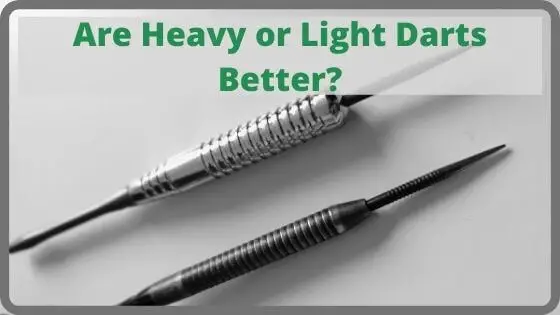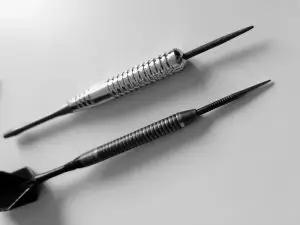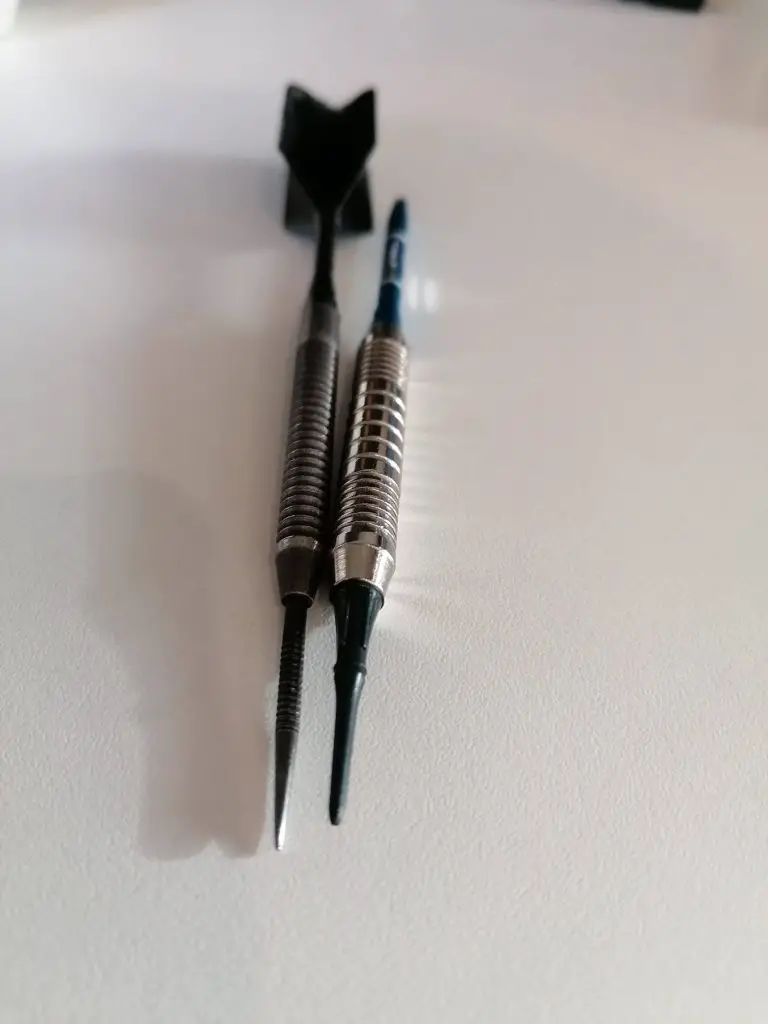Darts come in a variety of weights from 14g – 50g so it can seem a little daunting when you first browse the weight section for darts. With that said, most people playing darts will use a weight of 21g – 24g for steel tip darts or 16g – 20g for soft tip darts.
Keep in mind that this is an average though. We might be talking about the difference between a few grams in terms of weight (which doesn’t seem like much), but as darts is such an intricate and precise sport, the small change in weight can see you go from a comfortable and relaxed grip to being something you need to think about.
Choosing a weight for your darts is a very personal experience as it all comes down to individual comfort. In this article, we’ll help to answer the question “are heavy or light darts better” so that you can quickly find a set that’s best suited to your individual throw.
How Heavy are Darts
Steel tip darts weigh between 16g – 40g when fully assembled, however, the average weight used by most players is 21g – 24g. For soft tip darts, the average weight used is between 16g – 20g with 16g, 18, and 20g being the most commonly used soft tip weights.
The weight of a dart is custom designed and most dart ranges will have a base design for the barrel but will be available in a variety of different weights. While darts are available in a variety of weights, you also need to consider the fact that the weight distribution will also be different.
Depending on the product design, a particular set of darts can have a balance, front-loaded, or rear-loaded weight distribution which will impact how you hold and release the dart. For all these factors to think about, it can be difficult to know what weight and size dart to get – because the length and shape of the dart will also be dictated by the weight, or vice-versa…
Are Heavy or Light Darts Better?
Heavier darts weighing between 21g – 24g are better for beginners because they require less force when being thrown. This allows players to focus more on their aim. Once a player is comfortable with their grip they can test out different weights to see which suits their individual throw.
With the above being said, 21g – 24g isn’t necessarily heavy and is actually the average dart weight used by most dart players. This is because you don’t want to go to one extreme or another as a beginner and start playing with an incredibly heavy/light set of darts.
It should be a gradual process of testing a few different weights and barrel sizes to determine what best suits your grip, angle of release, and speed of your throw.
Heavy Darts vs Light Darts (a Comparison)
If you’re not completely new to darts, there are some key factors for each weight of dart that will make them better suited to your individual throw.
Something you should consider though is the size of the dart. We’ll explain this more later on but essentially – the material of the dart will dictate the weight and size of the barrel. If you like a slim barrel but heavier weight, this can be achieved by using tungsten so don’t think that just because you prefer (or want to test) a specific dart weight that will mean you need to use a certain type of dart.
It can be easy to assume that heavy darts are bigger as an example, however, that isn’t necessarily the case.
What are Heavy Darts
Heavy darts can be classified as weighing more than 26g. A heavy dart will therefore weigh between 26g – 40g and will typically be made if 80% or higher tungsten.
This is to keep the barrel of the dart relatively slim in relation to the weight, though many heavier darts will come with a larger barrel profile – especially brass or nickel darts.
Heavy Dart Pros
- Requires less force to throw the dart as the weight of the barrel takes over
- Can be easier to get a similar rhythm with each dart you throw
- Minimal bounce outs or lost darts as the weight of the dart ensures the dart stays in the board
- Fly straighter with a better trajectory
Heavy Dart Cons
- Can be bulky and difficult to group darts
- Darts will keep dropping too low if you don’t have a forceful throw
- Less balanced weight – will tend to be front-loaded or rear loaded
What are Light Darts
Light darts are typically those that weigh less than 20g. Most soft tip darts are typically 16g – 18g in weight and are lighter darts in general but for steel tip darts, anything under 20g will be considered light.
Light darts tend to have a more balanced weight throughout the dart and are favored by players that tend to throw with more force. For beginners though, it can be difficult to get a “feel” for these darts as the weight is not enough to comfortably master a grip and release (for most people).
Light Dart Pros
- Often have a very slim barrel which is great for grouping darts
- Better for players that throw with a lot of force
- If your dart drops low, lighter darts can help to minimize this
Light Dart Cons
- A light or lobbed throw makes lighter darts more difficult to keep in the board and is one key reason why your darts could keep falling out of the board
- Can be difficult to control or throw for beginners – especially those that haven’t grasped the basics of holding or releasing a dart yet
What Is the Best Weight for Darts?
The best weight for darts is between 21g – 24g. This is the average range that most dart players use and is also the average weight used by professional dart players. When looking at dart weights, the extremes for steel tip darts would be anything weighing more than 30g or anything weighing less than 18g.
At these weights, players would need to use them for noticeable preferences and these weights would not be comfortable for the average player to throw accurately.
Common Misconceptions
Are Lighter Darts More Accurate?
Because lighter darts are often smaller and slimmer, this is something that most people associate with accuracy. Larger, bulky items are not considered to be something that is used for accuracy but rather power or force so it’s easy to make the same assumption with darts.
Want a more forceful throw… use heavier darts.
Want a more accurate throw… use lighter darts.
This however isn’t true as a light dart made from a less dense material like brass will still be quite large in size. It’s worth saying that the throwing technique is what creates accuracy and the dart itself has minimal impact on how accurately the dart can be thrown.
A lighter dart could however be easier for most beginners to hold and use so from this perspective, a lighter dart could be more accurate when used by beginners or kids but as you get more skilled at throwing, the weight will no longer influence how accurate you throw.
Are Heavier Darts Always Bigger?
Another misconception is that heavier darts are always bigger but with dart manufacturing, the best material for the dart barrel is tungsten. The reason for this is that tungsten is a much more dense material than brass or nickel silver and therefore allows manufacturers to create a slimmer dart that is also heavier.
The reverse is actually true, brass darts are often the cheapest type of dart and this is because the material isn’t very dense. This essentially means that brass darts are lighter but also bigger than the tungsten alternative.
If you use a tungsten dart, the weight won’t matter to an extent as higher-grade tungsten will mean that you can make a heavy dart whilst still keeping a slim profile for the barrel which is essential for grouping of darts and heavy scoring!
For proof, just look at the difference between my 23g tungsten darts, 16g soft tip darts, and 21g nickel silver darts. You’d never know by glancing at them that the slim tungsten dart is actually the heaviest (the one with the dark grey barrel).
Final Thoughts
Dart weights are very specific to an individual, however, on average a weight of 21g – 24g is considered to be an ideal weight for most players. Very few players will use steel tip darts below a weight of 16g or above a weight of 30g so starting with a weight of 22g/23g will allow players some flexibility to move up or down weight in order to find the most ideal weight.
My first dart set was a 21g nickel silver dart which was surprisingly front-loaded in terms of weight. I then upgraded (in my opinion) to a Red Dragon Razor Edge set weighing 23g. These were 90% tungsten and have a noticeably slimmer barrel so, despite the increased weight, the balanced weight and slimmer dart meant that my game immediately improved.
This is why testing is important for beginners and as you can see, I fall firmly within the average weight range just as a result of testing what works for me. There are pros and cons to each dart weight and there is no “best” weight for a dart – it’s best to start at an average weight and make adjustments if needed.
As one final point, a good option is to opt for a slightly lighter weight than you think you’d need because you can always add weight to a dart through heavier accessories or tungsten putty but it’s much more difficult to reduce the weight of a dart.



